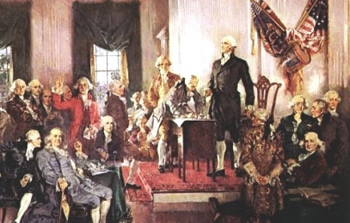Roots of the American Constitution
In the early days of our republic the United States was governed under our first constitution, the Articles of Confederation. However, by the end of the decade following our declaration of independence from Great Britain, it was clear that the nation was in trouble. In 1786 a convention was called to revise the Articles of Confederation, to be held in Philadelphia the following summer.

As delegates from each state traveled to the Convention, they knew that they had a momentous task. For the first time in the history of the world, a government had been established subject to the will of the people. The monarchies of the world watched to see if this great experiment, government without a monarch, could succeed. What was on the minds of the delegates as they traveled to Philadelphia in that hot summer of 1787?
Although the convention was called to revise the Articles of Confederation, many of the delegates believed that only a new Constitution would save the struggling nation. In the months before James Madison went to Philadelphia, he began reading numerous books and pamphlets sent to him by Thomas Jefferson. Madison had written to Thomas Jefferson, ambassador to France at the time, requesting that he send materials in preparation for the convention, and Jefferson sent more than two hundred different pieces written by European historians and philosophers. It is said that Madison read them all.
He knew, as did the other delegates, that designing a constitution that would serve the young nation and to last into her maturity would require not only a constitution but constitutionalism.
A constitution can be defined as a system of fundamental principles of government containing the structure, the powers, and the limitations on government. Constitutionalism is the principle requiring government to uphold and abide by the written constitution.
Constitutionalism can best be illustrated by considering its opposite. In 1977, the Soviet Union rewrote its constitution, including in it some fundamental rights of individuals such as economic equality and the right of individuals to practice their religion without fear or intimidation.
If you were reading that constitution, you might be ready to pack your bags and head for Moscow. However, upon arrival, you would see something very different from the equality and liberty found in the writing. Instead of economic equality, you would see special stores for the elite of the Communist party and long lines and shortages at the stores for the general populace. Outside the churches you would see party officials taking names of the people who go to worship. There were many contradictions between the Soviet Constitution of 1978 and the life and government of the people living under it.
Although they had written a shining new constitution, the Soviets did not utilize constitutionalism—that principle requiring government to uphold and abide by the written constitution.
The delegates to the convention of 1787 knew that not only must they design a new constitution; they must also include devices that would result in constitutionalism.